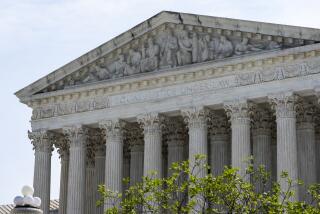Justices to Rule on Teacher-Student Sex
- Share via
WASHINGTON — The Supreme Court announced Friday that it will decide this term whether public schools and colleges can be held liable for a teacher’s sexual misconduct with a student.
A ruling on the issue, due by summer, could expose the nation’s educational institutions to a costly series of lawsuits.
Over the past two decades, plaintiff lawyers have tried, without much success, to win large damage awards for students who succumbed to sexual advances by teachers. They argued that the students’ constitutional rights were violated by negligent public officials.
This theory of liability based on the Constitution did not win the Supreme Court’s endorsement. Five years ago, however, the high court pointed to a more direct route that had been largely ignored.
Congress in 1972 had added Title IX to the federal civil rights code, a provision best known for having boosted women’s sports in high schools and colleges. It says simply that no person in a school or college that receives federal funds “shall be subjected to discrimination . . . on the basis of sex.”
Most lawyers thought this meant only that educational institutions must give equal opportunities to girls and boys.
But in 1992, to the surprise of many experts, the high court ruled that students who are victims of sexual abuse on campus can sue the school system for damages under Title IX.
This decision, in Christine Franklin vs. Gwinnett County Public Schools, opened the door to big lawsuits not just against individual teachers but also against entire school districts and colleges. However, the justices did not clarify under what circumstances the institution could be found liable.
Now that issue will be resolved in the case of Jane Doe vs. Lago Vista Independent School District, 96-1866.
Frank Waldrop, a retired U.S. Marine colonel who taught high school in a rural Texas district, gave special attention to a bright 15-year-old known only as Jane Doe. He invited her to join his Great Books class as a freshman. Soon after, he began a sexual relationship with her that lasted for several months, until they were caught together by a police officer.
The only hint of a potential problem with Waldrop came from a parent who complained to the school principal that Waldrop had made some suggestive comments about girls in his class.
*
Waldrop was fired and prosecuted. He pleaded guilty and received a 10-year suspended prison sentence.
The girl and her mother then filed a lawsuit against the school district, arguing it should have to pay for employing a teacher who would “sexually exploit” a young student.
Both a federal judge in Austin and the U.S. appeals court in New Orleans threw out the suit before a trial. Because school officials did not know of the sexual misconduct, the district cannot be held liable, the appeals court ruled.
But the girl’s attorney appealed to the high court. He urged the justices to rule that public school districts should be held liable whenever teachers or other school employees “use their inherent authority over the students and engage in sexual abuse and exploitation.”
Simply having a policy against sexual misconduct is not enough, said Terry L. Weldon, the girl’s lawyer. School systems that “turn a blind eye” to the problem of sexual abuse should not be “immunized from liability,” he said.
The federal Education Department’s office for civil rights took much the same view in a March policy directive. It suggested that school districts are liable for sexual harassment perpetrated by teachers or other employees.
An attorney for the school system urged the justices to consider the potential cost to the nation’s schools of making them liable for all sexual misconduct by their teachers.
Congress did not intend “to expose school districts to potential financial disaster for concealed acts of sexual discrimination,” attorney Wallace B. Jefferson of San Antonio told the court. He said the institutions should not be forced to pay unless they knew of the misconduct and did nothing about it.
The case will be argued before the court in late March, and a decision will be issued by July.
Last month, the justices agreed to decide a related issue involving employers. It has been unclear when companies or public agencies can be held liable for on-the-job sexual harassment of an employee.
More to Read
Get the L.A. Times Politics newsletter
Deeply reported insights into legislation, politics and policy from Sacramento, Washington and beyond. In your inbox twice per week.
You may occasionally receive promotional content from the Los Angeles Times.











